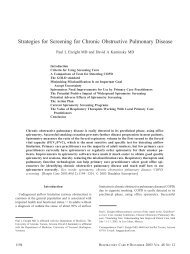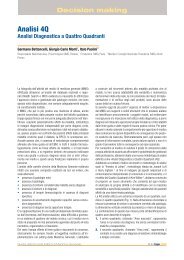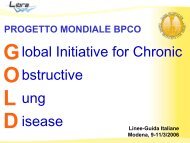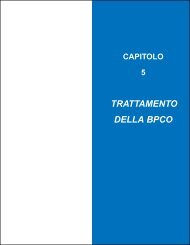COPD phenotypes - GOLD
COPD phenotypes - GOLD
COPD phenotypes - GOLD
Create successful ePaper yourself
Turn your PDF publications into a flip-book with our unique Google optimized e-Paper software.
Clinical Commentary 599<br />
ated with cigarette smoking, the discussion that follows relates<br />
only to <strong>COPD</strong> observed in smokers.<br />
The identification and subsequent grouping of key elements<br />
of the <strong>COPD</strong> syndrome into clinically meaningful and useful<br />
subgroups (<strong>phenotypes</strong>) that can guide therapy more effectively<br />
is a potential solution to this dilemma. Caution, however, is<br />
warranted when clustering patients with similar symptoms and<br />
clinical manifestations, as phenotyping in <strong>COPD</strong> is still a relatively<br />
young endeavor as compared with other fields. The<br />
novelty of <strong>COPD</strong> phenotyping is illustrated by the fact that<br />
a MEDLINE search revealed just over 400 phenotyping papers<br />
published in the field of <strong>COPD</strong>, whereas, for instance, it<br />
identifies more than 5,000 in breast cancer. Moreover, there is<br />
significant variation, confusion, and uncertainty surrounding use<br />
of the term phenotype in <strong>COPD</strong>. A common language for<br />
future research should facilitate our understanding of the<br />
heterogeneity implicit to this disease and help us design better<br />
alternatives for the prevention and management of the disease.<br />
This article discusses and refines the concept of phenotyping in<br />
<strong>COPD</strong> and presents a possible schema that can serve as<br />
a framework for future research.<br />
<strong>COPD</strong> PHENOTYPES: AN OPERATIONAL DEFINITION<br />
The classic definition of a phenotype reflects the observable<br />
structural and functional characteristics of an organism determined<br />
by its genotype and modulated by its environment:<br />
the interactions between ‘‘nature’’ and ‘‘nurture’’ (2). Although<br />
this definition has been historically useful in a variety of<br />
contexts (3), in medicine in general, and in <strong>COPD</strong> in particular,<br />
we believe this concept must be refined to more efficiently fulfill<br />
the following clinical and research goals. From a clinical and<br />
patient-centered perspective, a <strong>COPD</strong> phenotype should be<br />
able to classify patients into distinct subgroups that provide<br />
prognostic information and allow us to better determine<br />
appropriate therapy that alters clinically meaningful outcomes.<br />
From a research standpoint, phenotyping should allow us to<br />
select a uniform group of patients and assess the most important<br />
outcome measures in that group for therapeutic clinical trials.<br />
Phenotypes can also form the basis for biological mechanistic<br />
investigations. Hence the ultimate goal of phenotyping in<br />
medicine is to allow the identification of patient groups with<br />
unique prognostic or therapeutic characteristics. In <strong>COPD</strong> until<br />
now, disease characteristics and/or disease severity have frequently<br />
been termed <strong>COPD</strong> <strong>phenotypes</strong> (3).<br />
Accordingly, we propose the following variation on the<br />
traditional definition of a phenotype: ‘‘a single or combination<br />
of disease attributes that describe differences between individuals<br />
with <strong>COPD</strong> as they relate to clinically meaningful outcomes<br />
(symptoms, exacerbations, response to therapy, rate of<br />
disease progression, or death).’’ In other words, it is proposed<br />
that <strong>phenotypes</strong> in <strong>COPD</strong> should have real predictive value. It<br />
follows, therefore, that any proposed phenotype must be prospectively<br />
validated and refined for each of the outcomes to<br />
which it relates. Identifying the outcome is important as certain<br />
attributes, such as dyspnea, depression, or exacerbations, could<br />
be viewed as outcomes or <strong>phenotypes</strong> depending on the clinical<br />
context.<br />
Ideally, individuals clustering within a unique phenotype and<br />
exhibiting similar clinical outcomes should also exhibit a similar<br />
therapeutic response profile because of a similar underlying<br />
biologic or physiologic mechanism. At this point in time,<br />
however, the field of <strong>COPD</strong> phenotyping has not yet reached<br />
the stage at which we have significant understanding regarding<br />
the mechanism(s) behind every clinical presentation. We therefore<br />
believe that at this juncture, the proposed approach<br />
represents the best way forward. Ideally, by identifying patient<br />
subgroups that have unique characteristics as they relate to<br />
clinically meaningful outcomes, we may ultimately discover the<br />
etiologic mechanisms. However, it should also be pointed out<br />
that an understanding of mechanism is not necessarily required<br />
to significantly benefit patients and that the process of phenotype<br />
validation is an iterative one. As an example from the field<br />
of cardiology, the clinical effects of HMG-CoA reductase<br />
inhibitors (statins) were initially believed to be due largely to<br />
their cholesterol-lowering effect. Clinical trials, however,<br />
revealed benefit beyond what might be expected from changes<br />
in lipid levels alone, suggesting that statins likely have pleiotropic<br />
effects. This has led to further clinical trials, and the<br />
subgroup of patients who might benefit from statins has<br />
expanded from those with elevated cholesterol to those with<br />
elevated CRP. In <strong>COPD</strong>, the National Emphysema Treatment<br />
Trial identified a subgroup of patients with upper lobe–predominant<br />
emphysema and low exercise capacity who benefit<br />
from lung volume reduction surgery (LVRS), although a mechanistic<br />
explanation for benefit in this specific subgroup is not<br />
readily obvious. Such examples indicate how similar clinical<br />
response can identify <strong>phenotypes</strong> with immediate and direct<br />
implications for patients in the absence of a well-defined<br />
mechanism.<br />
It should be noted, however, that not all outcomes may be<br />
modifiable by (current) therapy, and that some outcomes may<br />
arise from multiple etiologic mechanisms. Furthermore, response<br />
to therapies can also be difficult to measure reliably<br />
and many of the treatments and measures we typically use (for<br />
example, FEV 1 ) may not be specific, well targeted, or sensitive<br />
enough to uniquely identify a phenotypic subgroup.<br />
POTENTIAL PHENOTYPES<br />
Here we discuss how disease attributes fit within the phenotyping<br />
framework we have proposed. As patient outcomes are<br />
a key component of the operational definition of phenotype<br />
proposed above, potential <strong>phenotypes</strong> are discussed within the<br />
clinical outcomes to which they relate.<br />
Clinical Manifestations<br />
Age, smoking history, sex, and ethnicity may all significantly<br />
impact disease presentation and progression. For example, lung<br />
function declines with increasing age (4). Female sex appears to<br />
be associated with worse quality of life (QOL) and higher rates<br />
of depression and anxiety; data suggest female sex may also be<br />
associated with higher susceptibility to the toxic effects of<br />
smoking (5). Women may also differ from men in the extent<br />
and distribution of airway abnormality and emphysema (5),<br />
which in themselves are not clinically relevant outcomes, but<br />
may relate to clinically relevant outcomes (see Radiologic<br />
Characterization section below). Body composition and dyspnea<br />
can be assessed with various instruments, and both descriptors<br />
appear to have independent prognostic value either as<br />
sole measures or as components of the body mass index (BMI),<br />
airflow obstruction, dyspnea, and exercise capacity (BODE)<br />
Index (6). Similarly, depression and anxiety have been independently<br />
associated with an increased frequency of hospital<br />
admissions and <strong>COPD</strong> exacerbation relapses (7, 8).<br />
Physiological Manifestations<br />
Spirometric indices, including FEV 1 , FVC, and their ratio, are<br />
used to define the presence and severity of disease. Unfortunately,<br />
these features explain less than 10 to 25% of the disease<br />
impact on patient symptoms, QOL, and exercise performance<br />
(9–11). Rapid physiologic progression as indicated by change in


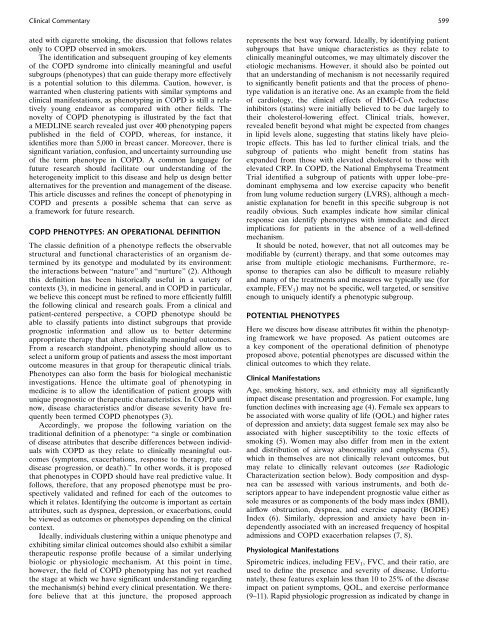

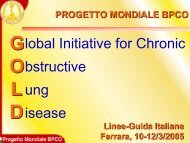
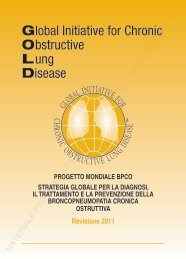
![Di Bari [NO].pdf - GOLD](https://img.yumpu.com/21544924/1/190x143/di-bari-nopdf-gold.jpg?quality=85)


